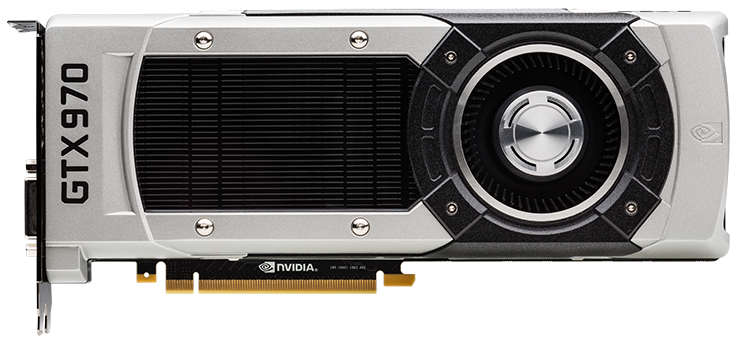Introduction
Nvidia's newly-unveiled GeForce GTX 980 will be hogging the majority of the launch-day limelight, but as was the case with previous-gen solutions, it's the second-rung card that arguably makes more sense to the majority of gamers.
Priced keenly compared to the top-of-the-range part, the second offering is typically better value for money and the formula used by Nvidia to derive a second-tier specification rarely alters: take the all-singing, all-dancing GPU, give it a snip here and a chop there, and hey presto, the next card in the product line is born.
Sticking with traditional naming conventions, Nvidia's latest #2 is the GeForce GTX 970, and going by past experiences of x70-series parts, it has a lot to live up to. Here's how it stacks up:
GeForce GTX 970 (4GB) |
||||||
|---|---|---|---|---|---|---|
| Launch date | September 2014 |
September 2014 |
May 2013 |
May 2013 |
March 2012 |
May 2012 |
| Codename | GM204 |
GM204 |
GK110 |
GK104 |
GK104 |
GK104 |
| Architecture | 28nm Maxwell |
28nm Maxwell |
28nm Kepler |
28nm Kepler |
28nm Kepler |
28nm Kepler |
| Transistors (billions) | 5.2 |
5.2 |
7.1 |
3.5 |
3.5 |
3.5 |
| Die Size (mm²) | 398 |
398 |
551 |
294 |
294 |
294 |
| SM Units | 16 |
13 |
13 |
8 |
8 |
7 |
| Cores | 2,048 |
1,664 |
2,304 |
1,536 |
1,536 |
1,344 |
| Texture Units | 128 |
104 |
192 |
128 |
128 |
112 |
| ROP Units | 64 |
64 |
48 |
32 |
32 |
32 |
| Base Clock (MHz) | 1,127 |
1,050 |
863 |
1,046 |
1,006 |
915 |
| Boost Clock (MHz) | 1,216 |
1,178 |
900 |
1,085 |
1,058 |
980 |
| Peak GFLOPS | 4,981 |
3,920 |
4,147 |
3,333 |
3,250 |
2,634 |
| Memory Clock (MHz) | 7,012 |
7,012 |
6,008 |
7,012 |
6,008 |
6,008 |
| Memory Bus (bits) | 256 |
256 |
384 |
256 |
256 |
256 |
| Max bandwidth (GB/s) | 224 |
224 |
288 |
224 |
192 |
192 |
| PCIe Power Connectors | 6+6 |
6+6 |
8+6 |
6+6 |
6+6 |
6+6 |
| TDP (watts) | 165 |
145 |
250 |
230 |
195 |
170 |
| GFLOPS per watt | 30.19 |
27.03 |
16.59 |
14.49 |
16.66 |
15.49 |
| Launch Price | $549 |
$329 |
$649 |
$399 |
$499 |
$399 |
The key differences between GTX 980 and 970 are clear to see: Nvidia expunges a trio of SM units, reducing core count to 1,664 and the number of texture units to 104. The cuts translate to a 21 per cent decrease in peak GFLOPS performance, but the 970's back-end remains intact, meaning a 4GB GDDR5 frame buffer allied to a 256-bit bus.
Truth be told, such numbers don't make for impressive reading. Going by specification alone, the new-look GTX 970 appears to be a backward step when compared to the aging GTX 780. But as hypothesised in our architecture analysis, the under-the-hood enhancements available to the 28nm Maxwell GPU should more than make up for the seemingly unspectacular specifications.
With an improved SMM scheduler, more L2 cache and a new compression engine amid the upgrades, we suspect the Maxwell-based GTX 970 will be able to outperform any previous-generation GPU. That would be some feat for a 145W card priced at $329.

And it is the price tag more so than the specification that makes Nvidia's GTX 970 worthy of your attention. Sure, you lose a bit in terms of GPU composition, and the cores are clocked slightly lower, but at $329 the second-placed card is a whopping 40 per cent cheaper than the full-fat GTX 980.
In an ideal world, we'd like to put Nvidia's reference card through its paces to see how the default specification stacks up. Unfortunately, reference boards are few and far between, as Nvidia has given carte blanche to add-in-board partners, all of whom are eager to show off their wares.
First up is EVGA, with the massively overclocked GeForce GTX 970 For The Win...









